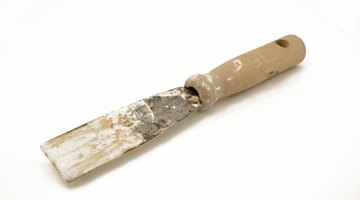How to Repair Pressboard Siding
Pressboard siding is an inexpensive siding option. The panels are usually sold in the form of T1-11, a panel shaped to look like a series of vertical siding boards. Pressboard is extremely susceptible to water damage. It must be painted to prevent moisture from getting into the board. The concept of repairing pressboard is something of a misnomer. Very minor damage, such as holes created by birds or insects, can be filled; but warping or rotting caused by water is the primary problem you will encounter with pressboard. In these cases, the boards need to be removed and replaced.
Repairing Minor Defects

-
Apply exterior wood putty to the defect with a putty knife. Work the putty down into the hole, and smear excess product over the edges and surface of the repair.
-
Consult the manufacturer's instructions regarding putty drying time. Typically, small repairs require a couple of hours for the putty to dry completely.
-
Sand the repair with 120-grit sandpaper. Work the putty until it is smooth and flush with the surface of the pressboard panel.
-
Paint the repair with exterior-grade house paint.

Replacing a Damaged Panel
-
Pry the damaged panel loose from the wall with a pry bar. Lift the panel until the nail shafts are exposed.
-
Pull the nails with a slate ripper, or cut the nail shafts with a hacksaw blade saw.
A slate ripper is a specialized tool designed for pulling nails. Slide the slate ripper underneath the pried panel, then grab and pull the nails free.
A hacksaw blade saw is a narrow, toothed saw blade mounted to a handle. Slide the hacksaw blade saw underneath the pried panel and cut the nail shafts to free the panel.
-
Pull the unfastened pressboard panel from the wall.
-
Cut the replacement panel to the appropriate size with a circular saw.
-
Position the replacement board in the vacated spot and fasten it in place using corrosion-resistant nails. Follow the existing nail patterns to achieve a consistent finish.
-
Paint the newly installed panel with exterior-grade house paint. Apply a single coat of primer followed by two coats of paint in the color of your choice.
References
Writer Bio
Robert Howard has been writing professionally since 2004 and writes a weekly column for the "Synthesis," a Chico, Calif.-based newspaper. He maintains a blog and has published articles and works of fiction in a variety of different print and online magazines. Howard holds a Bachelor of Arts in visual arts from the University of California, San Diego.
Photo Credits
- Barn Wood Background image by ryasick from Fotolia.com
- putty knife image by Jim Mills from Fotolia.com
More Articles



